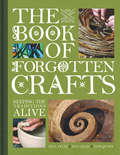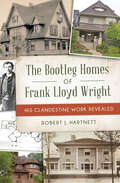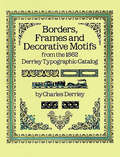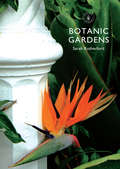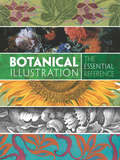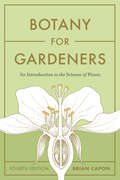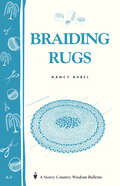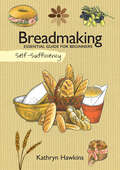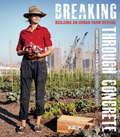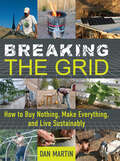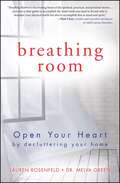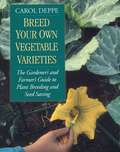- Table View
- List View
Bonsái para principiantes
by Nancy RossEl árbol Bonsái es una excelente opción para cualquier jardín. Aunque no provee el alimento ni la medicina como otras plantas lo hacen, el árbol Bonsái es capaz de proveer belleza al jardín y puede ser una muy buena manera de exhibir tu trabajo como jardinero, o incluso hacer un gran regalo. Aunque estos árboles vienen tradicionalmente de China y Japón, son fantásticos para tenerlos en el mundo occidental. Esta guía hablará de muchos temas acerca de lo que necesitas saber para comenzar a cultivar un Bonsái en tu propio hogar. Esta guía tendrá muchos temas sobre lo que necesitas saber para comenzar a cultivar tu propio Bonsái. Hablaremos sobre una variedad de temas como lo que es un árbol Bonsái, cómo elegir el mejor para principiantes, cómo replantar un árbol Bonsái, cómo podarlo, la importancia de darle la nutrición y el agua adecuada, y mucho más. Cuando termines de leer esta guía, serás capaz de volverte un experto en el cultivo de árboles Bonsái en muy poco tiempo. Cuando estés listo para comenzar a cultivar un Bonsái e intentar una forma única de jardinería en tu hogar, entonces ese será el momento adecuado para que aprendas más acerca del crecimiento de los Bonsái. ¡Esta guía te proporcionará toda la información que necesitas para comenzar el día de hoy!
Boogers, Witches, and Haints: The Foxfire Americana Library (5) (The Foxfire Americana Library)
by Inc. Foxfire FundA collection of spine-tingling Appalachian ghost stories and tall tales passed down from generation to generation. Whether they tell of faucets that drip blood, monster catfish that lurk at the bottom of quarries, or strange lights on the mountaintop, these stories will make you--like the people who are sharing them--question what you believe.
Book Nooks: Inspired Ideas for Cozy Reading Corners and Stylish Book Displays
by Vanessa Dina Claire GilhulyHome is where the books are. This inspiring home decor book is brimming with photos of cozy places to read and creative ways to display books at home.For stylish bookworms and bookish stylists, this covetable home décor book merges the literary appeal of Jane Mount’s bestselling Bibliophile with the aspirational allure of Emily Henderson’s bestselling Styled. Discover beautiful bookshelves adorned with lovely objets d’art, handsome home libraries with snug armchairs, reading areas for kids that ignite the imagination, and cookbook corners in quaint kitchens—and learn to replicate these in your own space.From bedside tables to bar carts, leather-bound collections to color-coded shelves, here are book nooks and styling techniques for every room and aesthetic. Reading lists from Gillian Flynn, Jasmine Guillory, Alex Elle, Joanna Goddard, Nik Sharma, and more offer plenty of recommendations for stocking your shelves (and your TBR list).In a stunning package with a tasteful hint of gold foil on the case, this sumptuous book is perfect for browsing, displaying on a coffee table, or gifting to the reader, book lover, designer, or creative in your life. Filled with clever design ideas and dreamy spaces, Book Nooks is an irresistible invitation to curl up with a book, whether this one or another.BOOK NOOKS FOR EVERYONE: Organized by type of book nook—from cookbook nooks to kid nooks, gardener nooks to neutral nooks—and featuring a range of home aesthetics, including colorful, contemporary, cozy, and whimsical, there is plenty of inspiration here for all readers.BEAUTIFUL TO GIFT AND DISPLAY: Book Nooks makes a lovely gift for design enthusiasts and book lovers. Not only is it filled with original ideas for styling your book collection, but it acts as an eye-catching décor object itself. Display it on a coffee table alongside a candle, decorative tray, or book-themed vase.INSPIRING AND EASY-TO-ACHIEVE: The styling ideas included in these pages are original yet easy to recreate at home: Fill a nonworking fireplace with paperbacks; stack oversized books to create a stool or end table; turn your book pages out for a neutral shelf; frame vintage cookbook pages for one-of-a-kind artwork. Discover tons of ideas that can be incorporated into your home, no matter the aesthetic or budget.READING LISTS FROM LUMINOUS VOICES: In addition to beautiful interior shots, you’ll find book lists, including Gillian Flynn’s favorite mysteries, Alex Elle’s most trusted books on healing and self love, Jasmine Guillory’s must-have romance novels, Nik Sharma’s most used cookbooks, PEN America’s recommended banned books, and more. Fill your shelves with their book recs and discover a new favorite!Perfect for:Reading enthusiasts, book lovers, and book club membersDesign aficionados, stylists, people interested in home decorFollowers of BookTok and people who post "shelfies"Fans of Bibliophile, Bibliostyle, Styled, or Art of the Bar CartShoppers looking for a birthday, housewarming, or anytime gift for a bookish friendReaders of Cup of Jo, Book Riot, Downtime on Substack, Design*Sponge, or Dwell
Book of Forgotten Crafts: Keeping The Traditions Alive
by Paul Felix Tom Quinn"Over the last years the interest in traditional trades and crafts grew constantly. People are looking for sustainability and a more rewarding and fulfilling lifestyle. The Book of Forgotten Crafts matches those interests and reveals the fascinating history of British craftsmanship in a series of interviews with leading crafters at work in Britain today."
Bootleg Homes of Frank Lloyd Wright, The: His Clandestine Work Revealed (Landmarks)
by Bob HartnettUncover the secret Chicago laboratory of Frank Lloyd Wright's Prairie Style. Before Frank Lloyd Wright officially launched America's most famous architectural career, he was designing the building blocks of his legendary prairie style on the side. In violation of his contract with his employers, Adler and Sullivan, Wright moonlighted as an independent architect from his Oak Park studio. From 1892 through the spring of 1893, he experimented with the elements that would become his signature in houses in Chicago, La Grange and Oak Park. The full roster of these "bootleg homes" has remained a matter of mystery and debate. Robert Hartnett seeks to provide the first definitive account of the hidden artifacts of Wright's storied legacy.
Borders, Frames and Decorative Motifs from the 1862 Derriey Typographic Catalog (Dover Pictorial Archive)
by Charles DerrieyIn the mid-19th century, typefounders plied their trade with an extraordinary exuberance, creating a new and dazzling range of typefaces and ornamentation that in sheer versatility, ornate beauty, and sumptuousness remain unsurpassed. Today, as never before, their work is sought by artists, designers, and craftspeople for its elegance, expressiveness, and ability to command attention.This unique volume contains the work of one of the most celebrated typefounders of that glorious era in type design: Charles Derriey, who, from his Parisian foundry, fed the Victorians' insatiable appetite for decoration and embellishment with a truly fabulous assortment of display types and printers' ornaments. The 113 plates reprinted here from his 1862 typographic catalog include over 2,500 royalty-free type forms and ornamental designs.Here is an incredibly rich source of intricately ornamented typefaces along with an eye-catching array of vignettes (dingbats, headpieces, tailpieces, etc.), rules, flourishes, corner elements, and much more, including a wide selection of Victorian frames and border material. Leaf through it and you will find it to be not only a fascinating presentation of type design, but also an extensive sampler of Victorian ornamentation -- a valuable reference book and source of royalty-free graphics, sturdily yet inexpensively produced, that will offer you years of inspiration, enjoyment, and practical use.
Botanic Gardens
by Sarah RutherfordAcross the world there are more than a thousand botanical gardens, which combine scientific research, conservation and beauty with public access - Kew Gardens alone attracts around one million visitors a year. Their uses have varied through history - they might focus on cultivating exotic plants and produce; be honed to commercial ends (introducing lucrative plant crops such as tea and rubber to new countries); center on preserving collections of international plants; focus on scientific classification and research - or combine of all these things. Sarah Rutherford here tells the story of these diverse gardens in Britain and around the world, from their beginnings in the sixteenth century to their long heyday in the last three hundred years. She explains the design of the gardens, the architecture employed, the personalities and institutions that established and contributed to them, their important role in research and conservation, and what makes them so appealing to the millions of visitors they attract.
Botanic Gardens of the World: Tales of extraordinary plants, botanical history and scientific discovery
by Deborah TrenthamDiscover the lavish beauty and fascinating history of the 40 most important and inspiring botanic gardens from across the globe.From the Renaissance gardens of Italy to the futuristic botanic gardens of Singapore, this gorgeous book tells the story of these unique institutions. It is a history of science and learning, of politics and national interests, of societal concerns and conservation. But, most of all, it is a compelling exploration of the power and possibility of the natural world, that we are still merely scratching the surface of.Expert garden historian Deborah Trentham has selected the world's most important gardens and delves deep into the history of these horticultural institutions - sharing stories of exploration, extraordinary plants and the scientific breakthroughs which have shaped these stunning gardens.Filled with rare and beautiful plants and incredible locations from around the globe - from Norway to Morocco, Kyoto to Kew, Brooklyn to Buenos Aires, and Madrid to Malaysia - this book will transport you to far-flung places and bygone eras, and consider the future of our botanical havens and the natural wonders they protect.
Botanic Gardens of the World: Tales of extraordinary plants, botanical history and scientific discovery
by Deborah TrenthamDiscover the lavish beauty and fascinating history of the 40 most important and inspiring botanic gardens from across the globe.From the Renaissance gardens of Italy to the futuristic botanic gardens of Singapore, this gorgeous book tells the story of these unique institutions. It is a history of science and learning, of politics and national interests, of societal concerns and conservation. But, most of all, it is a compelling exploration of the power and possibility of the natural world, that we are still merely scratching the surface of.Expert garden historian Deborah Trentham has selected the world's most important gardens and delves deep into the history of these horticultural institutions - sharing stories of exploration, extraordinary plants and the scientific breakthroughs which have shaped these stunning gardens.Filled with rare and beautiful plants and incredible locations from around the globe - from Norway to Morocco, Kyoto to Kew, Brooklyn to Buenos Aires, and Madrid to Malaysia - this book will transport you to far-flung places and bygone eras, and consider the future of our botanical havens and the natural wonders they protect.
Botanical Illustration: The Essential Reference
by Carol Belanger GraftonComprising more than 500 years of printed botanical illustrations, this stunning compendium of black-and-white and color images begins with medieval illuminated manuscripts and woodcuts from the early days of printing. In addition to images from the fifteenth and sixteenth centuries, the collection features highlights from such seventeenth-century classics as Gerard's Herbal, Besler's Hortus Eystettensis, and Crispin van de Pass' Hortus Floridus. Latter-day selections include illustrations from major nineteenth-century works -- including the great flower prints of Pierre-Joseph Redouté and hand-colored lithographs by many other artists of the period -- as well as the imaginative twentieth-century floral work in the Art Nouveau style of M. P. Verneuil, E. A. Seguy, and others.Detailed bibliographical information concerning every source and biographical information on the artists make this volume a vital reference tool as well as a splendid resource of significant and beautiful botanical illustrations. Students of graphic art and illustration as well as graphic designers, advertising professionals, and horticulturalists will prize this treasury of material from many rare historic sources.
Botanical Shakespeare: An Illustrated Compendium of all the Flowers, Fruits, Herbs, Trees, Seeds, and Grasses Cited by the World's Greatest Playwright
by Gerit QuealyA captivating, beautifully illustrated, one-of-a-kind color compendium of the flowers, fruits, herbs, trees, seeds, and grasses cited in the works of the world’s greatest playwright, William Shakespeare, accompanied by their companion quotes from all of his plays and poems. With a foreword by Dame Helen Mirren—the first foreword she has ever contributed.In this striking compilation, Shakespeare historian Gerit Quealy and respected Japanese artist Sumié Hasegawa combine their knowledge and skill in this first and only book that examines every plant that appears in the works of Shakespeare.Botanical Shakespeare opens with a brief look at the Bard’s relationship to the plants mentioned in his works—a diversity that illuminates his knowledge of the science of botany, as well as the colloquy, revealing his unmatched skill for creating metaphorical connections and interweaving substantive philosophy. At the heart of the book are "portraits" of the over 170 flowers, fruits, grains, grasses, trees, herbs, seeds and vegetables that Shakespeare mentions in his plays and poems. Botanical Shakespeare features a gorgeous color illustration of each, giving a "face" to the name, alongside the specific text in which it appears and the character(s) who utter the lines in which it is mentioned.This fascinating visual compendium also includes a dictionary describing each plant—such as Eglantine, a wild rose with a slight prickle, cherished for its singular scent, superior to any other rose; and the difference between apples and apple-john—along with indices listing the botanical by play/poem, by character, and genus for easy reference, ideal for gardeners and thoughtful birthday gift-giving.This breathtaking, incomparable collection of exquisite artwork and companion quotes offers unique depth and insight into Shakespeare and his timeless work through the unusual perspective of the plants themselves.
Botany for Gardeners (3rd edition)
by Brian CaponNew to the 3d edition of this well-illustrated text are four brief essays on human's relation to food, the possible impact of global warming on food supply, genetic modification of food, and the remarkable details to be seen with a scanning electron microscope. Other new additions are inset boxes expanding on the text with interesting facts and details, and additional photos. The volume, which is based on Capon's botany course for non-science majors (he is emeritus at California State U., Los Angeles) is an outstanding and enjoyable introduction to botany, whether the reader is a gardener, or just a garden visitor. Annotation ©2010 Book News, Inc., Portland, OR (booknews.com)
Botany for Gardeners, Fourth Edition: An Introduction to the Science of Plants
by Brian Capon&“This should be the cornerstone of every gardener&’s library.&” —Jeff Gillman, Director of the UNC Charlotte Botanical Gardens What happens inside a seed after it is planted? How are plants structured? How do plants reproduce? The answers to these and other questions about complex plant processes can be found in the bestselling Botany for Gardeners. First published in 1990 with more than 260,000 copies sold, it has become the go-to introduction to botany for students and gardeners. Now in its fourth edition, Botany for Gardeners has been expanded and updated. It features a revised interior, with new photos and illustrations that clarify the concepts clearer than ever before. Additional updates address scientific advances, changes in nomenclature and taxonomy, and more. As before, Botany for Gardeners shares accessible information about how plants are organized, how they have adapted to nearly all environments on earth, their essential functions, and how they reproduce.
Botany for Gardeners: Third Edition (Science For Gardeners Ser.)
by Brian CaponA bestseller since its debut in 1990, this indispensable and handy reference has now been expanded and updated to include an appendix on plant taxonomy and a comprehensive index. Two dozen new photos and illustrations make this new edition even richer with information. Its convenient paperback format makes it easy to carry and access, whether you are in or out of the garden. An essential overview of the science behind plants for beginning and advanced gardeners alike.
Bountiful Bonsai
by Richard BenderBonsai-the Japanese art of training plants to form elegant sculptures-is an age-old craft that appeals to gardeners and non-gardeners alike. Bountiful Bonsai presents a radical new approach that applies bonsai techniques to everyday container gardening, instantly turning houseplants and herbs into beautiful and unusual bonsai sculptures!Bonsai expert Richard Bender not only expects his plants to look good but to yield pleasant fragrances, fresh herbs and fruits for his table. He shows readers how to create "instant bonsai" by shaping a range of common house plants, including:Fragrant hibiscus and jasmineKitchen herbs such as rosemary and thyme Luscious fruits like cherries and oranges Medicinals such as tea tree and camphor laurelThis beautifully illustrated volume provides all the information you need to get started, from plant choice advice to care requirements and bonsai "carving" tips. Suitable for indoor gardening, or shaping exquisite bonsai fruit trees for outside gardens, Bender turns a finicky art into a hobby accessible to all. Bonsai have graced Japanese homes for centuries, now they can yield useful crops that will simultaneously satisfy your artistic sensibility and also provide some wonderful meals!
Boys and Their Toys: Understanding Men by Understanding Their Relationship with Gadgets
by Bill Adler"The key to understanding men is in understanding how they relate to their gadgets. Just because they may seem to show more interest in their computers. . . or their remote controls... or their fancy watches or their power mowers or their stereos... doesn't mean that their toys are really the most important things in their life. In Boys and Their Toys, bestselling author Bill Adler, Jr. explains how men use toys to assert their independence and freedom, relieve stress, connect to their lost childhood, and even express their nurturing side (without having to admit it). Written in Adler's fun, humorous style, the book reveals how women can: * learn how a man's interest in particular ""toys"" can be used to predict his behavior * know when a guy's passion for gadgets crosses the line into obsession and what to do about it * take advantage of the human-gadget relationship to improve the human-human relationship Smart and funny, Boys and Their Toys helps readers understand what makes their men tick. . . and grow closer with them in the process. "
Braiding Rugs: A Storey Country Wisdom Bulletin A-03 (Storey Country Wisdom Bulletin Ser.)
by Nancy BubelBraided rugs are like family quilts – each strip of cloth comes from a cast-off garment and tells a story all its own. Piecing the rug together is an act of weaving family memories into a useful heirloom you'll treasure forever. Nancy Bubel covers every step of the simple process, from planning the perfect size, shape, and color scheme to cutting your cloth strips, braiding them together, and finishing off your rug.
Braving Home: Dispatches from the Underwater Town, the Lava-Side Inn, and Other Extreme Locales
by Jake Halpern"every journalist has a niche - it's inevitable - and I was just a few days into my career when I stumbled upon mine. It started as a running joke at the office: I was the magazine's Bad Homes Correspondent. The production department quipped about changing my title on the masthead. I laughed it off, but some of the older writers definitely thought there was something wrong with me. "Did you grow up in some sort of dysfunctional household?" a senior editor asked. No, I told him. "Well, there's got to be something in your past that makes you interested in these stories-you ought to think about it." The magazine I worked for was the New Republic, and my co-workers were a mix of policy wonks, art critics, and political junkies. I was none of these, and instead of trying to pass as one, I set out to write a different kind of story; yet every time I did, it ended up being about some outlandish and often hellish place inhabited by a handful of stalwarts who refused to leave. Iron-willed, unfearing, and utterly immovable, these characters captured my imagination. They were the nation's toughest home-keepers, and I was their aspiring chronicler." A fascinating and witty book.
Breadmaking: Essential Guide for Beginners (Self-Sufficiency)
by Kathryn HawkinsJump on the breadmaking bandwagon with this guide to the basic techniques and ingredients that combine to make the perfect loaf. Making your own bread by hand is a simple pleasure and a great starting point for anyone looking to become a little more self-sufficient. It can be therapeutic and creative and is achievable with even a basic level of culinary skill. Filling your kitchen with the delicious smells of baking bread is reward enough in itself, but it is important that the finished product tastes great, too. Food writer and culinary stylist Kathryn Hawkins covers the basic steps to get you started, including essential equipment and simple breadmaking techniques. Also included are forty tasty bread recipes, from plain white to whole wheat loaves, sourdough to French baguettes, as well as recipes for flavored bread and international flare from every corner of the globe, including brioche, pita bread, naan, stollen, and soda bread. Charming artwork, simple instructions, and informative writing make Self-Sufficiency: Breadmaking an invaluable guide for anyone who&’s always wanted to make warm, delicious bread in their own home while becoming a little less reliant on processed, pre-packaged food. Get started today, and get ready to enjoy a lifetime of hot, fresh bread straight from your own oven.
Breaking Through Concrete
by Michael Hanson Mark Winne Edwin Marty David HansonPeople have always grown food in urban spaces--on windowsills and sidewalks, and in backyards and neighborhood parks--but today, urban farmers are leading an environmental and social movement that transforms our national food system. To explore this agricultural renaissance, brothers David and Michael Hanson and urban farmer Edwin Marty document twelve successful urban farm programs, from an alternative school for girls in Detroit, to a backyard food swap in New Orleans, to a restaurant supply garden on a rooftop in Brooklyn. Each beautifully illustrated essay offers practical advice for budding farmers, such as composting and keeping livestock in the city, decontaminating toxic soil, even changing zoning laws.
Breaking the Grid: How to Buy Nothing, Make Everything, and Live Sustainably
by Dan MartinAn all-encompassing, granular-level guide to building a successful off-the-grid homestead written by someone who had done it himself!
Breathing Room: Open Your Heart by Decluttering Your Home
by Melva Green Lauren RosenfeldCleaning out your cupboards isn’t just about a tidier kitchen. Find peace, repair your past, and live a more fulfilled life with this uplifting guide to the spiritual practice of decluttering.Bless your clutter. Yes, you heard right: Bless it. Bless everything in your life that is superfluous, broken, burdensome, and overwhelming—because it is all here to teach you an important lesson, perhaps the most important lesson there is: what really matters. Everyone’s lives could use some serious decluttering. But decluttering isn’t just about sorting junk into piles and tossing things in the trash. Decluttering can inform us of our burdens, help us to understand our attachments, and aid us in identifying what is truly valuable in our lives. Written by a medical doctor and a spiritual intuitive, with case studies of people just like you, Breathing Room takes you on an enlightening room-by-room tour where each room in your home corresponds to a “room” in your heart, and where decluttering will not just make space but improve the spirit. So, if it’s weighing you down, if it’s become an obstacle, if it’s making it near impossible for you to find the things you really love—it’s time for you to let it go and find a little breathing room.
Breed Your Own Vegetable Varieties: The Gardener's and Farmer's Guide to Plant Breeding and Seed Saving
by Carol DeppeBreeding and Seed Saving offers an exciting introduction to a whole new gardening adventure. It is a thorough guide to plant breeding and seed saving for the serious home gardener and the small-scale farmer or commercial grower.
Brew Ware: How to Find, Adapt & Build Homebrewing Equipment
by Mark Stevens Karl F. LutzenGear up with the right equipment and take the hassle out of homebrewing. <P><P>Karl E. Lutzen and Mark Stevens guide you through the best tools for all your brewing needs, from DIY homemade versions of commercial brewery equipment to simple devices that make brewing easier and safer. <P><P>Learn which gadgets and gizmos work best for measuring, mashing, bottling, kegging, and more. With the proper tools close at hand you’ll save both time and money, leaving you free to focus on enjoying your homebrewed beers.
Brewing with Cannabis: Using THC and CBD in Beer
by Keith VillaBrewing with Cannabis introduces the convergence of marijuana and brewing in the modern craft beer movement. Explore the varied history of how the cannabis plant became federally illegal and dive into both historic and current laws on decriminalization and legalization of cannabis in the U.S. Learn about the agriculture and biology of cannabis, unique characteristics of the plant, and the similarities between cannabis and hop plants. Find out all that is needed to successfully grow cannabis plants in the comfort of your own home (where state legal).Examine the active components of cannabis and the chemistry of how they interact with beer. Discover how to de-carboxylate THC-A into the fully psychoactive form of THC and learn methods of adding cannabis and CBD to non-alcoholic beer and homebrew for different effects. Delve into how and why the plant produces compounds such as cannabinoids and terpenes, how they function, and how to incorporate them into beer recipes. Both homebrewers and professional brewers will be inspired by a wide-range of extract-based and all-grain recipes they can adopt or use as guidance when creating non-alcoholic beer or homebrew. Designed as a practical guide to use in brewing, the final chapter will inspire readers on how the discovery of new cannabinoids and terpenes may be used in the future. This book will be especially useful to brewers seeking information on the responsible and state legal of use of cannabis in brewing.



